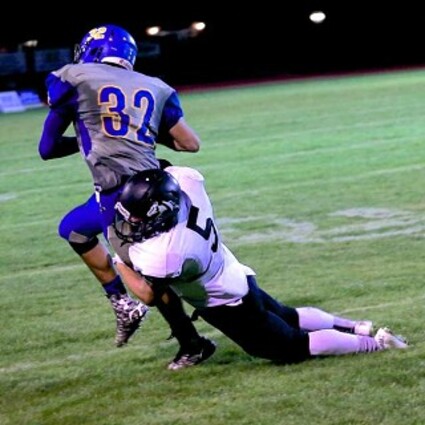Protecting Sisters youth from concussion
Last updated 1/26/2016 at Noon

Jerry Baldock
Football carries the risk of concussion. Teaching proper tackling technique is an important element in protecting players.
We've learned the hard way about the effects of concussion. From seeing NFL football players develop brain disease from years of hard hits to the head, to the life-changing debilitating experience of young athletes like Sisters' elite skier Jenna Sneva, to military personnel who have suffered traumatic brain injury in service to their country - most of us are just coming to grips with what it really means to "get your bell rung."
A concussion is a brain injury - and it's serious business. It's important to note that most athletes will get through their youth sports career without ever suffering a concussion. And most kids recover fully from a concussion in relatively short order, if treated properly. But in some cases there can be serious, long-lasting effects that cause difficulties in school, changes in mood and demeanor and leave parents dealing with a changed child.
The University of Oregon Center on Brain Injury and Training notes that: "Only recently have we begun to understand what happens to the brain during a concussion. In the past, people used the analogy that a concussion was a 'bruise to the brain.' It is actually a very complex event...
"A concussion results in a temporary, or in some cases lasting, disruption of normal brain function. It occurs when the brain is violently rocked back and forth or twisted inside the skull as a result of a blow to the head or body... This sudden movement of the brain causes stretching and tearing of brain cells, damaging the cells and creating chemical changes in the brain. Those chemical changes result in physical, emotional, and cognitive symptoms. Once those changes occur, the brain is vulnerable to further injury and sensitive to any increased stress until it fully recovers." (See related story, page 21.)
Sisters schools, parents and athletes are working now to ensure that local youth are protected from concussion as much as possible - and, most importantly, that they receive the proper care when concussions occur.
It's not always easy and straightforward.
A relatively less severe concussion can present serious symptoms. The location of a hit can affect symptoms. And the real danger comes when an athlete suffers another concussion before his or her brain has completely healed from the first. That can happen if coaches and other team personnel are not alert to a concussion and put an athlete back in a game - or the next game - before they are fully healed.
And hard-charging athletes - and their parents - want to get back into the game as quickly as possible.
Sisters schools have established a concussion and return-to-participation protocol in an effort to immediately identify potential concussion, get a kid assessed and keep them out of their sport and other activities until they are ready to return.
Coaches are trained in the concussion protocol.
"The concussion training is through the National Federation of State High School Associations," said Sisters High School Athletic Director Tim Roth. "It is an online training and they are tested on the material. We are required to take this training every year."
Some observers have questioned the efficacy of online training - concerned that it's just "checking the box" and doesn't impart to coaches the seriousness of the issue. However, it seems that online training is the current standard for youth sports coaches.
All athletes in contact sports get "baseline" testing through The Center Foundation, to help identify when a blow has disrupted their brain function.
"We've started testing kids at the middle school," Roth said. "So we've got baseline data on some of them for six years."
If a concussion is suspected, the athlete is removed from play and referred to trainer Alex Walker who works through The Center Foundation. The parent or guardian will be given an information packet on concussion, including descriptions of concussion signs and symptoms.
If testing is normal, the athlete can return. If tests are not normal, the injured student is required to sit out and rest and the school and the parents and students will develop accommodations in the classroom as needed (see related story, page 8).
The student will have to be medically cleared before returning to full participation.
Roth has faith in the protocol's effectiveness.
"I feel like our return-to-participation is pretty solid," he said. "I don't see holes in our RTP."
Athletes themselves can be a weak link - because they don't want to miss games due to injury of any kind. It's pretty easy to identify a severe hit from the sidelines - and coaches should be alert to odd behavior from a player. But it's also important that athletes themselves be willing to cop to symptoms, or report them in their peers.
"I wish we could guarantee that student-athletes would feel comfortable telling when they have symptoms," said SHS nurse Trish Roy.
Bob Collins, retired neurologist and co-founder of the Sisters Science Club, is working with Roth and other school officials to improve community outreach and education of parents, teachers, students, coaches and community regarding concussion.
Collins told The Nugget that self-reporting of symptoms is very important - and requires a cultural shift.
"I'd really like to inculcate that in the masculine culture of football," he said. "That's a smart and healthy thing to do, and it honors the game and it honors other players."
Collins provided The Nugget with a Minnesota Department of Health study that indicates that football has the highest incidence of concussion among youth sports, followed by girls soccer (heading), girls basketball and boys soccer. It is believed that girls are more vulnerable than boys in heading the ball because their neck strength may not be as capable of stabilizing the head under a blow.
Roth told The Nugget that he's seen fewer than 10 concussions this year, but some have been serious. Roy noted in an interview earlier this month that she had seen three new concussions that week.
Concussion is not viral - incidences can be reduced and the harm from them can be mitigated with proper protocols.
"The more I read, the more reassured I am that we can protect kids from brain injury in sports," Collins told The Nugget. "(The movie) 'Concussion' has sent out the scare - as it should - but the condition (CTE brain disease) is almost entirely focused on professional players who have head-butted for years. I mention all this because I don't want to over-sensitize high school kids and parents. High school sports are simply fabulous, and many studies find that student athletes get better grades when playing - AND make lifelong friends. HUGE...
"Educate everyone as much as possible. Protect and nourish the kid who gets a concussion; he/she will do fine with time."


















Reader Comments(0)